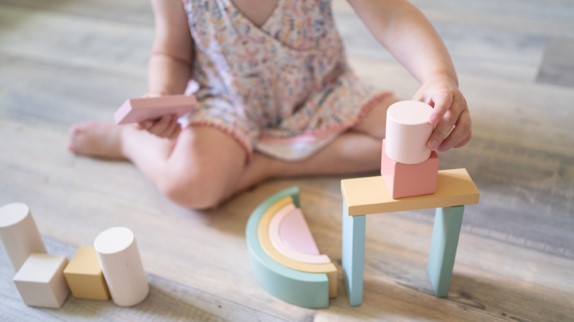The beloved children’s TV show host Mister Rogers was known to call play “the work of childhood.” And it really is! More than just a chance to have fun, play is how babies and toddlers learn about and interact with the world around them. So they need lots of time to do it — every single day.
Here’s why play is so important for your child, plus how much of the day should be devoted to just having fun.
Benefits of play for babies and toddlers
Playtime is fun for your little frolicker, but it’s also an important part of her overall health and wellbeing. In fact, regular playtime is integral for helping small children grow and develop both physically and psychologically.
According to the American Academy of Pediatrics (AAP), play:
- Encourages emotional development and resilience, including helping children work through hard feelings.
- Boosts self-confidence.
- Promotes physical dexterity and strength.
- Fosters imagination and creative thinking as well as problem-solving.
- Offers a chance to explore new roles, including practicing adult roles.
- Promotes social development, helping children learn how to work in groups, share, negotiate and resolve conflicts.
- Teaches children how to advocate for themselves.
- Gets children ready to learn at school.
Play is also an important way for parents and children to bond. You might catch the first glimpse of a smile from your infant while playing peekaboo or singing a silly song. As she grows into a toddler, playing together serves as a chance to help her learn valuable lessons and find effective ways to communicate with each other.
Most importantly, giving your child your full attention during playtime sends her the message that she matters and is loved.
How much playtime do babies need?
Babies should have opportunities to play every day. The AAP recommends that parents use play to help meet their child’s health and developmental needs starting at birth.
Read This Next
When it comes to active play in particular — think letting your sweet pea play or move freely on the floor with close supervision — more time is better, says the World Health Organization (WHO). Even young infants just a few days old should get two or three tummy time play sessions per day, each lasting three to five minutes.
Playing doesn’t have to mean entertaining your baby with toys all day long. While play with infants can involve exploring new objects like rattles or stuffed animals, there are plenty of other ways to interact and have fun together. Imitating your baby’s coos, singing songs, using a mirror to explore facial expressions or even just giving your baby space to explore how her body moves all count as valuable forms of playtime.
How much playtime do toddlers need?
Toddlers should have opportunities to play every day, the AAP says. Many experts recommend giving toddlers at least an hour per day of free, unstructured (but still supervised) play where children can explore what interests them, along with at least 30 minutes of active, adult-led, structured play.
Give your mover and shaker chances to play in lots of different ways. Letting your toddler explore toys alone or together is one fun option, but there are plenty of others. Head to the playground to run, jump and climb. Use simple objects around the house like small boxes or mixing bowls to encourage imaginative play. Make art or music. Get together with other kids and families, too, so your toddler has a chance to play socially.
Playtime ideas for babies and toddlers
Play can take many different forms — and as long as your cutie is having fun and being safe, there’s no right or wrong way to do it. If you’re looking for some guidance, these ideas can help you get started.
- Provide a variety of play opportunities. Active play, imaginative play, creative play (like using finger paint or crayons), sensory play (like playing with water or sand) and musical play stimulate your child in different ways. Plus, more variety means more fun!
- Let your child be the leader. Get involved when your child is playing but resist the urge to have her do things a certain way. Play is about exploring and experimenting, and there’s no right or wrong way to have fun. (As long as no one is at risk for getting hurt, of course.)
- Play games and sing songs. Playing games like patty-cake, peekaboo and nursery rhymes all count as play, and they’re one of the best ways to engage with young children.
- Pick open-ended toys. Choose toys that can be used in different ways, like blocks or dolls, over ones that only do one thing or don’t require much imagination.
- Put the screens away. Keeping play screen-free gives your child a chance to be creative, reflect and decompress, says the AAP. Stay off your phone when playing with your child, too, to show that you’re giving her your full attention.
- Head to a playgroup. Interacting with other babies and toddlers gives your child (and you) a chance to socialize and adds another dimension to playtime.
- Use materials you have at home. Sometimes the simplest objects end up being the most fun. Turn a small cardboard box into a playhouse or boat, make music with pots and pans, or make shadows on the wall with flashlights.
- Get outside. Toddlers never tire of running, jumping and climbing around the local playground or park. Even young babies love taking in the sights, sounds, noises and smells of the natural world — just bring a blanket for them to sit or lay on.





 Trending On What to Expect
Trending On What to Expect






